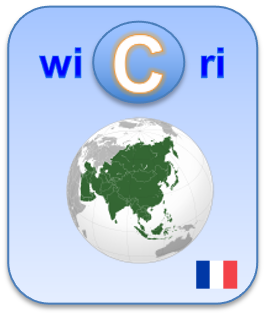Expression and characterization of the PEBP homolog genes from Drosophila
Identifieur interne : 000A31 ( Istex/Curation ); précédent : 000A30; suivant : 000A32Expression and characterization of the PEBP homolog genes from Drosophila
Auteurs : Gilles Rautureau [France, Australie] ; Laurence Jouvensal [France] ; Françoise Vovelle [France] ; Françoise Schoentgen [France] ; Daniel Locker [France] ; Martine Decoville [France]Source :
- Archives of Insect Biochemistry and Physiology [ 0739-4462 ] ; 2009-06.
Descripteurs français
English descriptors
- KwdEn :
- Accessory glands, Adult heads, Adult testes, Adult tissues, Archives, Biochemistry, Biological function, Biophysique moleculaire, Bovine brain, Bovine brain cytosol, Complete agreement, Cytosolic protein, Different paralogues, Different pebps, Different tissues, Differential expression pattern, Drosophila, Drosophila genome, Drosophila melanogaster, Drosophila pebps, Embryo, Escherichia coli, Expression pattern, Expression vector, Higher identity scores, Human pebp, Hydrophobic cluster analysis, Hydrophobic clusters, Imaginal discs, Immune response, Immunolocalisation experiment, Insect biochemistry, Jolles, June, Kinase, Kinase inhibitor protein, Larva, Larval tissues, Late spermatids, Late spermatogenesis, Malpighi tubules, Melanogaster, Mutant, Mutant testes, Numerous tissues, Nurse cells, Other pebp genes, Ovarian chambers, Ovary, Pebp, Pebp family, Pebp gene, Pebp genes, Pebp proteins, Pebps, Phosphatidylethanolamine, Phosphatidylethanolamine binding protein, Phosphatidylethanolamine binding proteins, Physiology, Physiology drosophila expression pattern, Primer, Protein, Protein expression pattern, Proteomic analysis, Restriction site, Ribosomal protein, Room temperature, Salivary glands, Same organism, Schoentgen, Secondary antibody, Secondary structure elements, Secondary structures, Sequence alignment, Sequence analysis, Sequence homology, Several pebps, Sperm decapacitation factor receptor, Spermatid, Spermatid differentiation, Spermatogenesis, Testis, Total proteins, Various adult tissues, Western blot, Western experiments, Wild type, Wiley periodicals.
- Teeft :
- Accessory glands, Adult heads, Adult testes, Adult tissues, Archives, Biochemistry, Biological function, Biophysique moleculaire, Bovine brain, Bovine brain cytosol, Complete agreement, Cytosolic protein, Different paralogues, Different pebps, Different tissues, Differential expression pattern, Drosophila, Drosophila genome, Drosophila melanogaster, Drosophila pebps, Embryo, Escherichia coli, Expression pattern, Expression vector, Higher identity scores, Human pebp, Hydrophobic cluster analysis, Hydrophobic clusters, Imaginal discs, Immune response, Immunolocalisation experiment, Insect biochemistry, Jolles, June, Kinase, Kinase inhibitor protein, Larva, Larval tissues, Late spermatids, Late spermatogenesis, Malpighi tubules, Melanogaster, Mutant, Mutant testes, Numerous tissues, Nurse cells, Other pebp genes, Ovarian chambers, Ovary, Pebp, Pebp family, Pebp gene, Pebp genes, Pebp proteins, Pebps, Phosphatidylethanolamine, Phosphatidylethanolamine binding protein, Phosphatidylethanolamine binding proteins, Physiology, Physiology drosophila expression pattern, Primer, Protein, Protein expression pattern, Proteomic analysis, Restriction site, Ribosomal protein, Room temperature, Salivary glands, Same organism, Schoentgen, Secondary antibody, Secondary structure elements, Secondary structures, Sequence alignment, Sequence analysis, Sequence homology, Several pebps, Sperm decapacitation factor receptor, Spermatid, Spermatid differentiation, Spermatogenesis, Testis, Total proteins, Various adult tissues, Western blot, Western experiments, Wild type, Wiley periodicals.
Abstract
The phosphatidylethanolamine binding proteins (PEBPs) family is evolutionarily conserved and involved in different physiological phenomena. PEBPs were found in many species from bacteria to mammals. Despite numerous studies, PEBPs' biological function and mode of action remain elusive. Based on sequence homology, seven PEBP genes were detected in the Drosophila genome. Only one of them, the odorant binding protein (OBP), has been characterized. To date nothing is known concerning the expression pattern and biological roles of the six other PEBP genes. By RT‐PCR and Western blot analysis, we examined expression of the PEBPs in different tissues and embryos. The 6 PEBPs were differentially expressed. Only one, CG10298, is specific of only one tissue: the testis. Additionally, by comparing in wild type and male‐sterile mutants we show that CG10298 is present only during spermatid differentiation. Furthermore, by comparing structural parameters of the six PEBP proteins with those of human PEBP‐1, we have established that PEBP CG10298 is most closely related to human PEBP. © 2009 Wiley Periodicals, Inc.
Url:
DOI: 10.1002/arch.20300
Links toward previous steps (curation, corpus...)
- to stream Istex, to step Corpus: Pour aller vers cette notice dans l'étape Curation :000A31
Links to Exploration step
ISTEX:3783C340A488E0338AC4E32CA0BA18994DE4FD3ALe document en format XML
<record><TEI wicri:istexFullTextTei="biblStruct"><teiHeader><fileDesc><titleStmt><title xml:lang="en">Expression and characterization of the PEBP homolog genes from Drosophila</title><author><name sortKey="Rautureau, Gilles" sort="Rautureau, Gilles" uniqKey="Rautureau G" first="Gilles" last="Rautureau">Gilles Rautureau</name><affiliation wicri:level="1"><mods:affiliation>Centre de Biophysique Moléculaire, UPR 4301 CNRS, Orléans, France</mods:affiliation><country xml:lang="fr">France</country><wicri:regionArea>Centre de Biophysique Moléculaire, UPR 4301 CNRS, Orléans</wicri:regionArea></affiliation><affiliation wicri:level="1"><mods:affiliation>Current Address: Walter and Eliza Hall Institute of Medical Research, 1 G Royal Parade, 3051 Parkville, Melbourne, Australia.</mods:affiliation><country xml:lang="fr">Australie</country><wicri:regionArea>Current Address: Walter and Eliza Hall Institute of Medical Research, 1 G Royal Parade, 3051 Parkville, Melbourne</wicri:regionArea></affiliation></author><author><name sortKey="Jouvensal, Laurence" sort="Jouvensal, Laurence" uniqKey="Jouvensal L" first="Laurence" last="Jouvensal">Laurence Jouvensal</name><affiliation wicri:level="1"><mods:affiliation>Centre de Biophysique Moléculaire, UPR 4301 CNRS, Orléans, France</mods:affiliation><country xml:lang="fr">France</country><wicri:regionArea>Centre de Biophysique Moléculaire, UPR 4301 CNRS, Orléans</wicri:regionArea></affiliation></author><author><name sortKey="Vovelle, Francoise" sort="Vovelle, Francoise" uniqKey="Vovelle F" first="Françoise" last="Vovelle">Françoise Vovelle</name><affiliation wicri:level="1"><mods:affiliation>Centre de Biophysique Moléculaire, UPR 4301 CNRS, Orléans, France</mods:affiliation><country xml:lang="fr">France</country><wicri:regionArea>Centre de Biophysique Moléculaire, UPR 4301 CNRS, Orléans</wicri:regionArea></affiliation></author><author><name sortKey="Schoentgen, Francoise" sort="Schoentgen, Francoise" uniqKey="Schoentgen F" first="Françoise" last="Schoentgen">Françoise Schoentgen</name><affiliation wicri:level="1"><mods:affiliation>Centre de Biophysique Moléculaire, UPR 4301 CNRS, Orléans, France</mods:affiliation><country xml:lang="fr">France</country><wicri:regionArea>Centre de Biophysique Moléculaire, UPR 4301 CNRS, Orléans</wicri:regionArea></affiliation></author><author><name sortKey="Locker, Daniel" sort="Locker, Daniel" uniqKey="Locker D" first="Daniel" last="Locker">Daniel Locker</name><affiliation wicri:level="1"><mods:affiliation>Centre de Biophysique Moléculaire, UPR 4301 CNRS, Orléans, France</mods:affiliation><country xml:lang="fr">France</country><wicri:regionArea>Centre de Biophysique Moléculaire, UPR 4301 CNRS, Orléans</wicri:regionArea></affiliation></author><author><name sortKey="Decoville, Martine" sort="Decoville, Martine" uniqKey="Decoville M" first="Martine" last="Decoville">Martine Decoville</name><affiliation wicri:level="1"><mods:affiliation>Centre de Biophysique Moléculaire, UPR 4301 CNRS, Orléans, France</mods:affiliation><country xml:lang="fr">France</country><wicri:regionArea>Centre de Biophysique Moléculaire, UPR 4301 CNRS, Orléans</wicri:regionArea></affiliation><affiliation wicri:level="1"><mods:affiliation>E-mail: decovil@cnrs‐orleans.fr</mods:affiliation><country wicri:rule="url">France</country></affiliation><affiliation wicri:level="1"><mods:affiliation>Correspondence address: Centre de Biophysique Moléculaire, UPR 4301 CNRS affiliated to Orléans University and to INSERM, Rue Charles Sadron, 45071 Orléans cedex 2, France</mods:affiliation><country xml:lang="fr">France</country><wicri:regionArea>Correspondence address: Centre de Biophysique Moléculaire, UPR 4301 CNRS affiliated to Orléans University and to INSERM, Rue Charles Sadron, 45071 Orléans cedex 2</wicri:regionArea></affiliation></author></titleStmt><publicationStmt><idno type="wicri:source">ISTEX</idno><idno type="RBID">ISTEX:3783C340A488E0338AC4E32CA0BA18994DE4FD3A</idno><date when="2009" year="2009">2009</date><idno type="doi">10.1002/arch.20300</idno><idno type="url">https://api.istex.fr/document/3783C340A488E0338AC4E32CA0BA18994DE4FD3A/fulltext/pdf</idno><idno type="wicri:Area/Istex/Corpus">000A31</idno><idno type="wicri:explorRef" wicri:stream="Istex" wicri:step="Corpus" wicri:corpus="ISTEX">000A31</idno><idno type="wicri:Area/Istex/Curation">000A31</idno></publicationStmt><sourceDesc><biblStruct><analytic><title level="a" type="main" xml:lang="en">Expression and characterization of the PEBP homolog genes from <hi rend="italic">Drosophila</hi><ref type="note" target="#fn1"></ref></title><author><name sortKey="Rautureau, Gilles" sort="Rautureau, Gilles" uniqKey="Rautureau G" first="Gilles" last="Rautureau">Gilles Rautureau</name><affiliation wicri:level="1"><mods:affiliation>Centre de Biophysique Moléculaire, UPR 4301 CNRS, Orléans, France</mods:affiliation><country xml:lang="fr">France</country><wicri:regionArea>Centre de Biophysique Moléculaire, UPR 4301 CNRS, Orléans</wicri:regionArea></affiliation><affiliation wicri:level="1"><mods:affiliation>Current Address: Walter and Eliza Hall Institute of Medical Research, 1 G Royal Parade, 3051 Parkville, Melbourne, Australia.</mods:affiliation><country xml:lang="fr">Australie</country><wicri:regionArea>Current Address: Walter and Eliza Hall Institute of Medical Research, 1 G Royal Parade, 3051 Parkville, Melbourne</wicri:regionArea></affiliation></author><author><name sortKey="Jouvensal, Laurence" sort="Jouvensal, Laurence" uniqKey="Jouvensal L" first="Laurence" last="Jouvensal">Laurence Jouvensal</name><affiliation wicri:level="1"><mods:affiliation>Centre de Biophysique Moléculaire, UPR 4301 CNRS, Orléans, France</mods:affiliation><country xml:lang="fr">France</country><wicri:regionArea>Centre de Biophysique Moléculaire, UPR 4301 CNRS, Orléans</wicri:regionArea></affiliation></author><author><name sortKey="Vovelle, Francoise" sort="Vovelle, Francoise" uniqKey="Vovelle F" first="Françoise" last="Vovelle">Françoise Vovelle</name><affiliation wicri:level="1"><mods:affiliation>Centre de Biophysique Moléculaire, UPR 4301 CNRS, Orléans, France</mods:affiliation><country xml:lang="fr">France</country><wicri:regionArea>Centre de Biophysique Moléculaire, UPR 4301 CNRS, Orléans</wicri:regionArea></affiliation></author><author><name sortKey="Schoentgen, Francoise" sort="Schoentgen, Francoise" uniqKey="Schoentgen F" first="Françoise" last="Schoentgen">Françoise Schoentgen</name><affiliation wicri:level="1"><mods:affiliation>Centre de Biophysique Moléculaire, UPR 4301 CNRS, Orléans, France</mods:affiliation><country xml:lang="fr">France</country><wicri:regionArea>Centre de Biophysique Moléculaire, UPR 4301 CNRS, Orléans</wicri:regionArea></affiliation></author><author><name sortKey="Locker, Daniel" sort="Locker, Daniel" uniqKey="Locker D" first="Daniel" last="Locker">Daniel Locker</name><affiliation wicri:level="1"><mods:affiliation>Centre de Biophysique Moléculaire, UPR 4301 CNRS, Orléans, France</mods:affiliation><country xml:lang="fr">France</country><wicri:regionArea>Centre de Biophysique Moléculaire, UPR 4301 CNRS, Orléans</wicri:regionArea></affiliation></author><author><name sortKey="Decoville, Martine" sort="Decoville, Martine" uniqKey="Decoville M" first="Martine" last="Decoville">Martine Decoville</name><affiliation wicri:level="1"><mods:affiliation>Centre de Biophysique Moléculaire, UPR 4301 CNRS, Orléans, France</mods:affiliation><country xml:lang="fr">France</country><wicri:regionArea>Centre de Biophysique Moléculaire, UPR 4301 CNRS, Orléans</wicri:regionArea></affiliation><affiliation wicri:level="1"><mods:affiliation>E-mail: decovil@cnrs‐orleans.fr</mods:affiliation><country wicri:rule="url">France</country></affiliation><affiliation wicri:level="1"><mods:affiliation>Correspondence address: Centre de Biophysique Moléculaire, UPR 4301 CNRS affiliated to Orléans University and to INSERM, Rue Charles Sadron, 45071 Orléans cedex 2, France</mods:affiliation><country xml:lang="fr">France</country><wicri:regionArea>Correspondence address: Centre de Biophysique Moléculaire, UPR 4301 CNRS affiliated to Orléans University and to INSERM, Rue Charles Sadron, 45071 Orléans cedex 2</wicri:regionArea></affiliation></author></analytic><monogr></monogr><series><title level="j" type="main">Archives of Insect Biochemistry and Physiology</title><title level="j" type="alt">ARCHIVES OF INSECT BIOCHEMISTRY AND PHYSIOLOGY</title><idno type="ISSN">0739-4462</idno><idno type="eISSN">1520-6327</idno><imprint><biblScope unit="vol">71</biblScope><biblScope unit="issue">2</biblScope><biblScope unit="page" from="55">55</biblScope><biblScope unit="page" to="69">69</biblScope><biblScope unit="page-count">15</biblScope><publisher>Wiley Subscription Services, Inc., A Wiley Company</publisher><pubPlace>Hoboken</pubPlace><date type="published" when="2009-06">2009-06</date></imprint><idno type="ISSN">0739-4462</idno></series></biblStruct></sourceDesc><seriesStmt><idno type="ISSN">0739-4462</idno></seriesStmt></fileDesc><profileDesc><textClass><keywords scheme="KwdEn" xml:lang="en"><term>Accessory glands</term><term>Adult heads</term><term>Adult testes</term><term>Adult tissues</term><term>Archives</term><term>Biochemistry</term><term>Biological function</term><term>Biophysique moleculaire</term><term>Bovine brain</term><term>Bovine brain cytosol</term><term>Complete agreement</term><term>Cytosolic protein</term><term>Different paralogues</term><term>Different pebps</term><term>Different tissues</term><term>Differential expression pattern</term><term>Drosophila</term><term>Drosophila genome</term><term>Drosophila melanogaster</term><term>Drosophila pebps</term><term>Embryo</term><term>Escherichia coli</term><term>Expression pattern</term><term>Expression vector</term><term>Higher identity scores</term><term>Human pebp</term><term>Hydrophobic cluster analysis</term><term>Hydrophobic clusters</term><term>Imaginal discs</term><term>Immune response</term><term>Immunolocalisation experiment</term><term>Insect biochemistry</term><term>Jolles</term><term>June</term><term>Kinase</term><term>Kinase inhibitor protein</term><term>Larva</term><term>Larval tissues</term><term>Late spermatids</term><term>Late spermatogenesis</term><term>Malpighi tubules</term><term>Melanogaster</term><term>Mutant</term><term>Mutant testes</term><term>Numerous tissues</term><term>Nurse cells</term><term>Other pebp genes</term><term>Ovarian chambers</term><term>Ovary</term><term>Pebp</term><term>Pebp family</term><term>Pebp gene</term><term>Pebp genes</term><term>Pebp proteins</term><term>Pebps</term><term>Phosphatidylethanolamine</term><term>Phosphatidylethanolamine binding protein</term><term>Phosphatidylethanolamine binding proteins</term><term>Physiology</term><term>Physiology drosophila expression pattern</term><term>Primer</term><term>Protein</term><term>Protein expression pattern</term><term>Proteomic analysis</term><term>Restriction site</term><term>Ribosomal protein</term><term>Room temperature</term><term>Salivary glands</term><term>Same organism</term><term>Schoentgen</term><term>Secondary antibody</term><term>Secondary structure elements</term><term>Secondary structures</term><term>Sequence alignment</term><term>Sequence analysis</term><term>Sequence homology</term><term>Several pebps</term><term>Sperm decapacitation factor receptor</term><term>Spermatid</term><term>Spermatid differentiation</term><term>Spermatogenesis</term><term>Testis</term><term>Total proteins</term><term>Various adult tissues</term><term>Western blot</term><term>Western experiments</term><term>Wild type</term><term>Wiley periodicals</term></keywords><keywords scheme="Teeft" xml:lang="en"><term>Accessory glands</term><term>Adult heads</term><term>Adult testes</term><term>Adult tissues</term><term>Archives</term><term>Biochemistry</term><term>Biological function</term><term>Biophysique moleculaire</term><term>Bovine brain</term><term>Bovine brain cytosol</term><term>Complete agreement</term><term>Cytosolic protein</term><term>Different paralogues</term><term>Different pebps</term><term>Different tissues</term><term>Differential expression pattern</term><term>Drosophila</term><term>Drosophila genome</term><term>Drosophila melanogaster</term><term>Drosophila pebps</term><term>Embryo</term><term>Escherichia coli</term><term>Expression pattern</term><term>Expression vector</term><term>Higher identity scores</term><term>Human pebp</term><term>Hydrophobic cluster analysis</term><term>Hydrophobic clusters</term><term>Imaginal discs</term><term>Immune response</term><term>Immunolocalisation experiment</term><term>Insect biochemistry</term><term>Jolles</term><term>June</term><term>Kinase</term><term>Kinase inhibitor protein</term><term>Larva</term><term>Larval tissues</term><term>Late spermatids</term><term>Late spermatogenesis</term><term>Malpighi tubules</term><term>Melanogaster</term><term>Mutant</term><term>Mutant testes</term><term>Numerous tissues</term><term>Nurse cells</term><term>Other pebp genes</term><term>Ovarian chambers</term><term>Ovary</term><term>Pebp</term><term>Pebp family</term><term>Pebp gene</term><term>Pebp genes</term><term>Pebp proteins</term><term>Pebps</term><term>Phosphatidylethanolamine</term><term>Phosphatidylethanolamine binding protein</term><term>Phosphatidylethanolamine binding proteins</term><term>Physiology</term><term>Physiology drosophila expression pattern</term><term>Primer</term><term>Protein</term><term>Protein expression pattern</term><term>Proteomic analysis</term><term>Restriction site</term><term>Ribosomal protein</term><term>Room temperature</term><term>Salivary glands</term><term>Same organism</term><term>Schoentgen</term><term>Secondary antibody</term><term>Secondary structure elements</term><term>Secondary structures</term><term>Sequence alignment</term><term>Sequence analysis</term><term>Sequence homology</term><term>Several pebps</term><term>Sperm decapacitation factor receptor</term><term>Spermatid</term><term>Spermatid differentiation</term><term>Spermatogenesis</term><term>Testis</term><term>Total proteins</term><term>Various adult tissues</term><term>Western blot</term><term>Western experiments</term><term>Wild type</term><term>Wiley periodicals</term></keywords><keywords scheme="Wicri" type="topic" xml:lang="fr"><term>Archives</term><term>Biochimie</term></keywords></textClass></profileDesc></teiHeader><front><div type="abstract" xml:lang="en">The phosphatidylethanolamine binding proteins (PEBPs) family is evolutionarily conserved and involved in different physiological phenomena. PEBPs were found in many species from bacteria to mammals. Despite numerous studies, PEBPs' biological function and mode of action remain elusive. Based on sequence homology, seven PEBP genes were detected in the Drosophila genome. Only one of them, the odorant binding protein (OBP), has been characterized. To date nothing is known concerning the expression pattern and biological roles of the six other PEBP genes. By RT‐PCR and Western blot analysis, we examined expression of the PEBPs in different tissues and embryos. The 6 PEBPs were differentially expressed. Only one, CG10298, is specific of only one tissue: the testis. Additionally, by comparing in wild type and male‐sterile mutants we show that CG10298 is present only during spermatid differentiation. Furthermore, by comparing structural parameters of the six PEBP proteins with those of human PEBP‐1, we have established that PEBP CG10298 is most closely related to human PEBP. © 2009 Wiley Periodicals, Inc.</div></front></TEI></record>Pour manipuler ce document sous Unix (Dilib)
EXPLOR_STEP=$WICRI_ROOT/Wicri/Asie/explor/AustralieFrV1/Data/Istex/Curation
HfdSelect -h $EXPLOR_STEP/biblio.hfd -nk 000A31 | SxmlIndent | more
Ou
HfdSelect -h $EXPLOR_AREA/Data/Istex/Curation/biblio.hfd -nk 000A31 | SxmlIndent | more
Pour mettre un lien sur cette page dans le réseau Wicri
{{Explor lien
|wiki= Wicri/Asie
|area= AustralieFrV1
|flux= Istex
|étape= Curation
|type= RBID
|clé= ISTEX:3783C340A488E0338AC4E32CA0BA18994DE4FD3A
|texte= Expression and characterization of the PEBP homolog genes from Drosophila
}}
|
| This area was generated with Dilib version V0.6.33. | |

